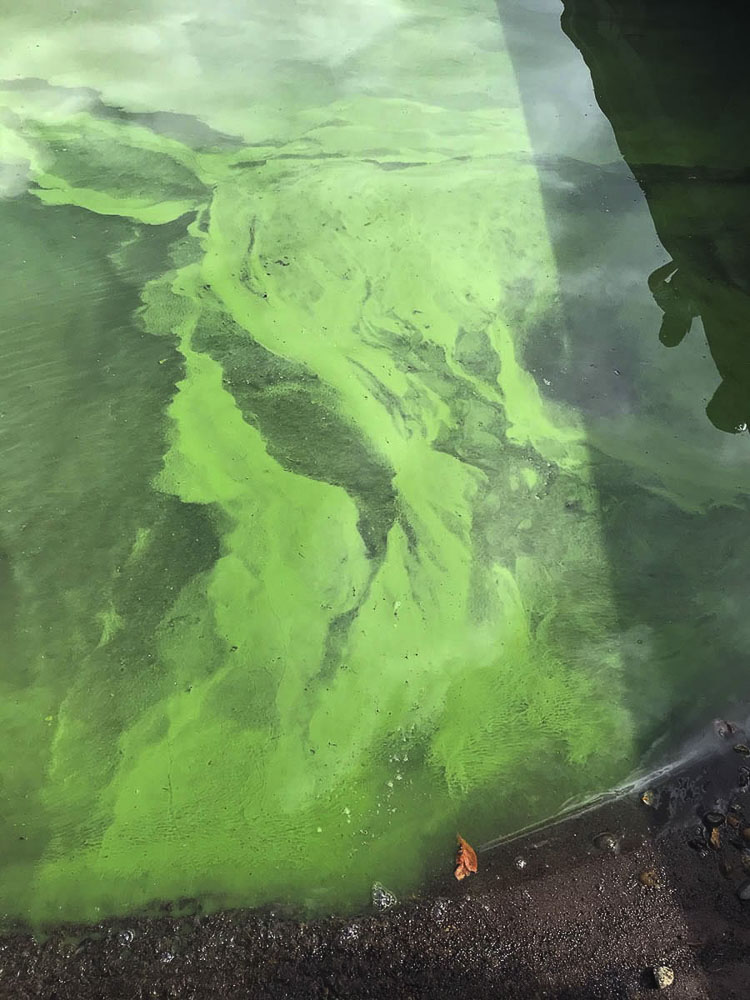Clark County Public Health issues toxic algae warning for two Camas lakes
The Clark County Public Health Department has issued a public health warning to citizens for Lacamas Lake and Round Lake water quality. The Washington State Toxic Algae site shows water quality tests were taken Aug. 2 and 9. On both dates, levels of microcystin exceeded state guidelines.
Water quality at the two lakes was in nearly constant levels of public health “caution” or “warning” for most of last year.
Camas resident Marie Callerame shared the following information on Nextdoor.
“Ecology’s website just populated this morning with a sample collected 8/9. The result for microcystin is higher than it has EVER been recorded in our lakes – 3 times higher than the highest reading! It measured as 261 µg/L. This is over 40 times the state guideline of 6 µg/L, well over dog-kill level.”

She shared that microcystin is a liver toxin. Symptoms include rash, hives, or skin blisters (skin contact); stomach pain, nausea, vomiting, diarrhea, severe headaches, and fever (ingesting); and runny eyes and nose, cough, and sore throat, chest pain, asthma-like symptoms, or allergic reactions (inhalation of particles).
Callerame mentioned the city’s social media post that one person’s dog wound up in the emergency room last week because of algae toxins.
The city of Camas shared the following warning.
“Please remember that harmful algal blooms have been reported in Lacamas Lake and Round Lake. Toxins from algae in the water can harm people and kill animals. Shallow areas have more opportunity for algae growth, please avoid those areas.” (CCPH advisories).
An area citizen reported her family dog got sick from the water. “Our dog ended up in the emergency room this week due to this,” she said on social media. They had walked the dog on Lacamas Creek, (downstream of the two lakes).
Last fall, Callerame enlisted the help of other concerned citizens to test the water entering and exiting the LSHOA biofilter. They paid a private firm to test water samples they collected, and Clark County Today was there to document the collection process. The phosphorus, conductivity, and total suspended solids were measured. A complete report was provided to the city by Callerame earlier this spring.
The phosphorus can “feed” the toxic algae blooms in the lake water. Callerame found that total phosphorus exiting the Lacamas Shores HOA biofilter was higher than it was entering the biofilter. The biofilter was adding phosphorus and other pollutants to the lake water.

In 2020, to many residents, it seemed like there was almost no time there weren’t “caution” or “warning” signs displayed around the lake. Reported testing results indicated toxic algae blooms occurred over a dozen times. Various “toxins” exceeded state guidelines multiple times during the year. Microcyctin exceeded state guidelines 14 times and anatoxin exceeded guidelines once.
The Camas City Council approved spending $300,000 in their annual budget to study lake water quality issues. On June 7 they authorized spending $106,400 for a consultant to further study Lacamas Lake water quality issues. They expect a report next spring.
The health department advises that citizens and their pets should stay out of the water. Do not consume the water. You shouldn’t fish, swim or boat in the water. “It is important to avoid contact with areas of scum and activities that provide a higher risk of exposure during a harmful algal bloom event,” they say.




